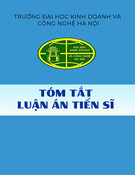1 2
2. Xác định được diến biến AMH trong vòng 6 tháng sau mổ ĐẶT VẤN ĐỀ nội soi bóc nang lạc nội mạc tử cung tại buồng trứng.
3. Xây dựng được mô hình hồi qui giải thích cho sự thay đổi AMH sau mổ, từ đó xác định được yếu tố ảnh hưởng đến dự trữ buồng trứng sau mổ. 4.Xác định được điểm cắt dự báo nguy cơ giảm dự trữ buồng trứng tại các thời điểm sau mổ dựa vào nồng độ AMH trước mổ. 5. Xác định được điểm cắt của mức độ giảm AMH sau mổ 1 tháng tiên lượng khả năng hồi phục một phần AMH sau mổ 6 tháng.
6. Kết quả của nghiên cứu có giá trị ứng dụng trong lâm sàng cao, đặc biệt ở những bệnh nhân vô sinh có LNMTC tại buồng trứng. CẤU TRÚC CỦA LUẬN ÁN
Nang lạc nội mạc tử cung (LNMTC) tại buồng trứng là bệnh lý phụ khoa thường gặp với các biểu hiện lâm sàng chính là đau và vô sinh. Mổ nội soi bóc nang là phương pháp điều trị được ứng dụng rộng rãi nhưng có thể ảnh hưởng đến dự trữ buồng trứng - một yếu tố có vai trò quan trọng để tiên lượng khả năng sinh sản của người phụ nữ. Tuy nhiên cho đến nay, sau mổ nội soi bóc nang LNMTC, dự trữ buồng trứng thay đổi như thế nào, phụ thuộc vào những yếu tố gì và có thể dự báo được hay không vẫn chưa được sáng tỏ. Có nhiều test được dùng để đánh giá dự trữ buồng trứng nhưng Hormone kháng ống Muller (Anti - Mullerian Hormone - AMH) được coi là một trong những test có giá trị nhất. Chính vì vậy, đề tài nghiên cứu “Đánh giá sự thay đổi dự trữ buồng trứng bằng Anti – Mullerian Hormone (AMH) sau mổ nội soi bóc nang lạc nội mạc tử cung tại buồng trứng” được tiến hành với 2 mục tiêu: 1.
Luận án gồm 123 trang không kể phụ lục, các bảng, biểu đồ, sơ đồ, hình và 130 tài liệu tham khảo, trong đó: đặt vấn đề và mục tiêu nghiên cứu 2 trang, tổng quan tài liệu 37 trang, đối tượng và phương pháp nghiên cứu 16 trang, kết quả nghiên cứu 27 trang, bàn luận 38 trang, kết luận 2 trang và kiến nghị 1 trang. 2. Đánh giá sự thay đổi dự trữ buồng trứng bằng AMH sau mổ nội soi bóc nang LNMTC 1tháng, 3 tháng, 6tháng. Xác định một số yếu tố liên quan đến sự thay đổi nồng độ AMH sau mổ nội soi bóc nang LNMTC. Chương 1: TỔNG QUAN TÀI LIỆU Ý NGHĨA KHOA HỌC VÀ THỰC TIỄN CỦA LUẬN ÁN 1.1. Nang lạc nội mạc tử cung tại buồng trứng
Lạc nội mạc tử cung (LNMTC) là sự hiện diện của mô tuyến nội mạc tử cung và mô đệm ở bên ngoài tử cung gây ra tình trạng viêm mạn tính, phát triển và thoái triển theo chu kỳ kinh nguyệt và chịu ảnh hưởng của nội tiết tố sinh dục.
Mổ nội soi bóc nang LNMTC tại buồng trứng là phương pháp điều trị đang được áp dụng rộng rãi trên lâm sàng, đề tài này là cơ sở để xác định mức độ giảm của dự trữ buồng trứng, những yếu tố ảnh hưởng đến mức độ giảm dự trữ buồng trứng sau mổ, từ đó giúp cho các bác sĩ lâm sàng thận trọng trong việc chỉ định và thực hiện phẫu thuật nội soi bóc nang LNMTC, giúp tư vấn cho bệnh nhân lựa chọn phương pháp điều trị phù hợp nhằm bảo tồn khả năng sinh sản cho người bệnh. NHỮNG ĐÓNG GÓP MỚI CỦA LUẬN ÁN 1. Xác định được mức độ giảm AMH sau mổ nội soi bóc nang lạc nội mạc tử cung tại buồng trứng. Nang lạc nội mạc tử cung ở buồng trứng là hình thái lạc nội mạc tử cung thường gặp và thường phối hợp với lạc nội mạc tử cung ở nhiều vị trí khác nhau. Nang lạc nội mạc tử cung cũng gây bệnh cảnh chính là đau và vô sinh, điều trị nang lạc nội mạc tử cung với việc mổ nội soi bóc nang đã được khuyến cáo nhưng vẫn còn nhiều bàn cãi vì ảnh hưởng đến dự trữ buồng trứng và khả năng sinh sản của người bệnh.
3 4
1.2. Các test dự trữ buồng trứng 1.3.2. Các yếu tố ảnh hưởng đến AMH 1.3.2.1. Thay đổi nồng độ AMH theo tuổi
Cho đến nay, chưa có test dự trữ buồng trứng nào được coi là lý tưởng, nhưng dựa trên những bằng chứng y học, năm 2012, Hiệp Hội Sản phụ khoa Hoa Kỳ đưa ra khuyến cáo về sử dụng các test dự trữ buồng trứng, trong đó AMH và AFC vẫn là 2 test có giá trị nhất trong đánh giá dự trữ buồng trứng Trước dậy thì: AMH thay đổi với 2 đỉnh là ngay sau sinh và trước dậy thì, tuy nhiên nồng độ đều ở mức thấp. Sau dậy thì, nồng độ AMH tăng dần để đạt đỉnh quanh 25 tuổi sau đó giảm đều đặn cho đến khi không phát hiện được nữa tương ứng thời kỳ mãn kinh. 1.3.2.2. Thay đổi nồng độ AMH khi có thai Các Test dự trữ buồng trứng được khuyến cáo Nồng độ AMH giảm mạnh sau khi có thai và tăng nhanh ngay Giá trị
sau khi sinh. 1.3.2.3. Thay đổi nồng độ AMH theo chu kỳ kinh nguyệt Nồng độ AMH có độ biến thiên giữa các chu kỳ KN thấp và
Test FSH phối hợp E2 không thay đổi giữa các ngày khác nhau trong một chu kỳ KN. 1.3.2.4. Thay đổi nồng độ AMH giữa các cá thể Nồng độ AMH thay đổi giữa các cá thể khác nhau được giải AMH
thích là do mật độ nang noãn giữa các cá thể không giống nhau. 1.3.2.5. Ảnh hưởng của các yếu tố di truyền và môi trường - Chủng tộc: Nồng độ AMH không giống nhau giữa các chủng tộc khác nhau. AFC - Hút thuốc lá: Cho đến nay, tác động của thuốc lá đến dự trữ buồng trứng và AMH vẫn chưa được sáng tỏ. - Xét nghiệm máu vào ngày 2 – 3 của kỳ kinh - Có thể thay đổi giữa các chu kỳ kinh nguyệt - Nồng độ cao FSH liên quan đến đáp ứng kém với KTBT - Không có giá trị dự báo không có thai - Có thể xét nghiệm vào bất kỳ ngày nào của kỳ kinh nguyệt - Giá trị ổn định trong một chu kỳ và giữa các chu kỳ KN - Nồng độ thấp AMH liên quan đến đáp ứng kém với KTBT - Không có giá trị dự báo không có thai - Số lượng nang noãn quan sát được qua SA đầu dò âm đạo - Thực hiện vào ngày 2 – 5 của chu kỳ kinh nguyệt - Số lượng nang noãn liên quan đến đáp ứng với KTBT - Không có giá trị dự báo không có thai - Béo phì: nồng độ AMH giảm và BMI tăng chỉ là yếu tố nhiễu trong mối quan hệ với tuổi. - Thuốc tránh thai: có tác động ức chế sự chế tiết AMH ít 1.3. Anti – Mullerian Hormone (AMH) 1.3.1. Sinh lý học Anti – Mullerian Hormone 1.3.1.1. Nguồn gốc AMH nhất khi dùng trong một thời gian dài - Gen và biến thể của gen: có ảnh hưởng đến AMH. 1.3.3. Các loại xét nghiệm AMH
AMH là một phân tử gồm 2 chuỗi glycoprotein, có trọng lượng phân tử 140KDa, thuộc nhóm các yếu tố tăng trưởng và biệt hóa TGF – β. AMH được chế tiết ra bởi các tế bào hạt của các nang nhỏ của buồng trứng. AMH có nhiều nhất ở các nang tiền hốc và có hốc nhỏ, không còn ở các nang phát triển phụ thuộc FSH (>8mm) và các nang thoái triển. 1.3.1.2. Vai trò AMH trong sinh lý buồng trứng AMH có tác dụng điều hòa tình trạng tạo noãn bằng việc hạn Có nhiều loại xét nghiệm AMH như IOT, DSL và AMH Gen II Elisa nhưng có nhiều hạn chế. Từ năm 2014, 2 loại xét nghiệm AMH tự động hoàn toàn được đưa vào sử dụng là Elecsys và Access 2 với nhiều ưu việt như ngưỡng phát hiện thấp, sai số thấp, thời gian ủ mẫu ngắn, không chịu tác động bởi bổ thể và con người. chế sự chiêu mộ quá mức các nang noãn của FSH.
5 6
Chương 2 ĐỐI TƯỢNG VÀ PHƯƠNG PHÁP NGHIÊN CỨU 2.2. Phương pháp nghiên cứu 2.2.1. Thiết kế nghiên cứu Nghiên cứu theo dõi dọc so sánh trước - sau 2.2.2. Cỡ mẫu nghiên cứu Được tính theo công thức ước tính cỡ mẫu cho một nghiên cứu theo dõi dọc so sánh sự thay đổi trung bình ở 2 thời điểm.
2.1. Đối tượng nghiên cứu Đối tượng nghiên cứu bao gồm các bệnh nhân được phẫu thuật nội soi bóc nang lạc nội mạc tử cung buồng trứng tại Bệnh viện Phụ sản Hà Nội trong thời gian nghiên cứu (từ 01/01/2015 đến 30/10/2016) và đồng ý tham gia nghiên cứu. 2.1.1. Tiêu chuẩn lựa chọn 22
d (z1-/2 + z1-)2
n = 2
- Tuổi: từ 18 – 40 với chu kỳ kinh nguyệt từ 21 – 35 ngày. - Được chẩn đoán là có nang lạc nội mạc tử cung tại buồng trứng qua siêu âm với kích thước nang > 3cm kèm theo các triệu chứng như đau, vô sinh và có chỉ định mổ nội soi bóc nang LNMTC buồng trứng. - Được chẩn đoán xác định là nang lạc nội mạc tử cung Lực mẫu (chọn = 0,8) buồng trứng qua nội soi và qua kết quả giải phẫu bệnh lý. - Tự nguyện tham gia nghiên cứu. Với α=0,05 thì z 1-α/2=1,96. Với = 0,8 thì z1- = 0,84 2.1.2. Tiêu chuẩn loại trừ
- Có tiền sử phẫu thuật tại buồng trứng trước đó. - Có nang lạc nội mạc tử cung tại buồng trứng kèm theo u nang buồng trứng khác. α: Mức ý nghĩa thống kê (chọn α=0,05) z: Giá trị thu được từ bảng z ứng với giá trị α, được chọn d: Độ lệch chuẩn của sự thay đổi : Độ chính xác của ước lượng n: Cỡ mẫu nghiên cứu Thay vào công thức trên, với: Có hội chứng buồng trứng đa nang theo tiêu chuẩn củaRotterdam 2003. - Dùng bất kỳ loại thuốc nội tiết nào trong vòng 3 tháng trước : Độ lệch chuẩn của sự thay đổi, lấy theo phân tích gộp về sự thay đổi của AMH sau mổ bóc nang LNMTC của Francesca Raffi và cs (2012) thì = 0,3775 phẫu thuật. Độ chính xác của ước lượng, lấy = 0,15 (ứng với độ chính xác 5% của nồng độ trung bình AMH là 3,0 ng/ml).
- Có kèm theo bất cứ bệnh lý rối loạn nội tiết nào như: đái tháo đường, bệnh lý tuyến giáp, prolactin cao, tăng sản thượng thận bẩm sinh, hội chứng Cushing...
2 x 0,37752 (1,96 + 0,84)2 = 99,3 - Có thai trong thời gian nghiên cứu. - Bỏ nghiên cứu. n = 0,152
Ta được: Như vậy, cỡ mẫu nghiên cứu tối thiểu là 100 bệnh nhân.
7 8
2.2.4. Thu thập số liệu - Phỏng vấn, khám lâm sàng, siêu âm, xét nghiệm để có được 2.2.3. Quy trình nghiên cứu 2.2.3.1. Chọn đối tượng nghiên cứu Bệnh nhân có chỉ định mổ nội soi bóc nang LNMTC buồng trứng các biến số nghiên cứu
- Nghiên cứu viên trực tiếp hỏi bệnh và siêu âm trước mổ, trực tiếp tham gia/theo dõi các cuộc mổ, trực tiếp khám cho bệnh nhân sau mổ và thu thập, quản lý, xử lý số liệu. 2.2.5. Các tiêu chuẩn trong nghiên cứu - Nghiên cứu viên sẽ hỏi bệnh và thu thập thông tin theo mẫu. - Nghiên cứu viên sẽ trực tiếp siêu âm kiểm tra lại: hình ảnh siêu âm nghi ngờ nang LNMTC buồng trứng: là khối có giới hạn rõ, bờ khá dày, bên trong có chứa dịch với tính chất dịch tăng âm đều hoặc bên trong chứa dịch và cục máu đông, cặn lắng. - Bệnh nhân sẽ được xét nghiệm AMH trước mổ 2.2.3.2. Đánh giá trong quá trình phẫu thuật - Bệnh nhân được mổ nội soi bóc nang LNMTC tại buồng
- Nghiên cứu viên cùng phẫu thuật viên trực tiếp đánh giá và - Tuổi: tính theo năm. - BMI: tính bằng cân nặng chia cho bình phương của chiều cao - Chỉ số điểm đau: được tính theo thang điểm NRS - mức độ đau được cho điểm từ 0 đến 10 tương ứng với mức độ từ không đau đến đau nhất, được tính cho mức độ đau nhất của bệnh nhân ở cả 3 hình thái: đau khi giao hợp, đau khi có kinh nguyệt, và đau vùng hạ vị.
- Vô sinh: là tình trạng vợ chồng sau 1 năm sống chung, có quan hệ tình dục bình thường, không sử dụng bất kỳ biện pháp tránh thai nào mà người vợ vẫn chưa có thai.
trứng theo đúng qui trình phẫu thuật. cho điểm lạc nội mạc tử cung theo rASRM. - Nghiên cứu viên tính thời gian mổ. - Bệnh nhân không có tai biến trong phẫu thuật (như tổn thương tạng, phải cắt buồng trứng vì lý do cầm máu,…), được chẩn đoán xác định là LNMTC qua nội soi và qua kết quả GPBL sẽ được đưa vào nghiên cứu. - Số lượng nang LNMTC: tổng số nang LNMTC qua siêu âm - Vị trí nang LNMTC (số bên): là sự có mặt của nang LNMTC ở 1 bên hay 2 bên buồng trứng.
- Kích thước nang LNMTC: xác định qua siêu âm, được tính bằng trung bình của 2 đường kính: đường kính lớn, và đường kính nhỏ vuông góc với đường kính lớn. + Qua nội soi ổ bụng: là nang buồng trứng trong có chứa dịch màu socholar, có thể quan sát thấy có LNMTC ở vị trí khác, có chỗ màu nâu hay màu đen, có chỗ màu đỏ tối hay màu trắng (thể không hoạt động) hay có kèm phản ứng viêm toàn bộ phúc mạc tiểu khung hay xơ hóa tạo viêm dính phúc mạc và 2 phần phụ… - Tổng kích thước nang LNMTC: tính bằng tổng kích thước
của tất cả các nang LNMTC ở cả 2 bên buồng trứng. - Kích thước trung bình nang LNMTC: + Khi nang ở 1 bên BT: tính bằng tổng kích thước các nang. + Khi nang ở 2 bên BT: tính bằng tổng kích thước các nang ở từng bên rồi chia cho 2. - Thời gian mổ: được tính từ khi phẫu thuật viên đưa được đầy + Qua GPBL: tổ chức LNMTC có cấu trúc giống NMTC bình thường, là biểu mô tuyến hình trụ cổ điển, nhiều tế bào và tổ chức đệm dày đặc. 2.2.3.3. Theo dõi sau phẫu thuật - Bệnh nhân trong nghiên cứu sẽ được gọi điện mời đến khám lại sau mổ, đánh giá điểm đau, siêu âm và xét nghiệm AMH tại 3 thời điểm 1tháng ± 1 tuần, 3tháng ± 1 tuần, 6tháng ± 1 tuần sau mổ. đủ các dụng cụ mổ nội soi vào ổ bụng đến khi bắt đầu rút trocarts.
9 10
- Nồng độ AMH trước mổ (AMH0): là nồng độ AMH được xét nghiệm ở thời điểm trước mổ 1 – 2 ngày. Chương 3 KẾT QUẢ NGHIÊN CỨU
3.1. Thay đổi AMH sau mổ nội soi bóc nang LNMTC tại BT 3.1.1. Đặc điểm của bệnh nhân trong nghiên cứu Bảng 3.1: Đặc điểm của bệnh nhân trong nghiên cứu - Nồng độ AMH sau mổ: AMHi trong đó i = 1, 3, 6 - là nồng độ AMH được xét nghiệm sau mổ tương ứng 1 tháng ± 1 tuần, 3 tháng ± 1 tuần, 6 tháng ± 1 tuần. - Thay đổi AMH sau mổ:
dAMHi = x 100% [AMH0]- [AMHi] [AMH0] (i = 1, 3, 6 ứng với thời điểm 1 tháng, 3 tháng và 6 tháng sau mổ). + Kết quả có dấu “dương” thể hiện nồng độ AMH giảm đi Đặc điểm Tuổi BMI NRS0 Vô sinh sau mổ hay giảm dự trữ buồng trứng = Mức độ giảm AMH sau mổ. trí + Kết quả có dấu “âm” thể hiện nồng độ AMH tăng lên sau 48/104 46,15 56/104 53,85 77/104 74,04 27/104 25,96 Có Không 1 bên 2 bên
mổ hay tăng dự trữ buồng trứng = Mức độ tăng AMH sau mổ. - Giảm dự trữ buồng trứng (DOR):
+ Khi nồng độ AMH < 1,1ng/ml (Bologna - 2011) + Trong đó DORi (i = 0,1,3,6) tương ứng với giảm dự trữ ở
56/104 53,85 48/104 46,15 3 4 Min Max n/tổng % 39 19 26,7 15,2 9 0 3,2 15,2 10,6 504,8 0,24 14,14 118 20 110 20 X ± SD 29,03 5,31 19,83 2,12 5,24 2,46 6,69 2,49 93,63 88,54 4,47 2,88 46,14 25,97 50,24 19,64 Xét nghiệm AMH tự động toàn Access 2 - Berman Counter Vị nang Tổng KT nang CA125 AMH0 Điểm rASRM GĐ rASRM Thời gian mổ 3.1.2. Diễn biến nồng độ AMH sau mổ 3.1.3. Nồng độ AMH trước và sau mổ các thời điểm trươc mổ, sau mổ 1 tháng, 3 tháng và 6 tháng. - Hồi phục: Hồi phục sau 6 tháng nếu: [AMH6] > [AMH1] - Điểm và giai đoạn LNMTC: Phân loại theo rASRM 1996 2.3. Xét nghiệm AMH 2.4. Phương pháp xử lý số liệu Bảng 3.2: Nồng độ AMH trước và sau mổ 1 th, 3 th, 6 th
AMH
- Số liệu được nhập và quản lý bằng phần mềm Epi Data 3.1. - Số liệu xử lý và phân tích bằng chương trình Stata 14.0 với
Min - Max
việc sử dụng các thuật toán thống kê phù hợp.
X SD
AMH (ng/ml)
Trung vị (25% - 75%)
3,77 (2,28 – 6,31) 0,43 – 13,63
- p< 0,05 biểu thị sự khác biệt có ý nghĩa thống kê.
4,47 2,88
1,60 (0,77 – 3,01)
0,02 – 7,48
2.5. Khống chế sai số và các yếu tố nhiễu 2.6. Đạo đức trong nghiên cứu
2,11 1,88
1,66 (0,82 – 2,47)
0,01 – 7,89
1,96 1,67
Thời điểm Trước mổ AMH0 Sau mổ 1th AMH1 Sau mổ 3th AMH3 Sau mổ 6th AMH6
p1/0, p3/0, p6/0 < 0,0001
- Nghiên cứu tuân thủ đầy đủ các qui định về nghiên cứu y sinh, đối tượng nghiên cứu tự nguyện tham gia sau khi được cung cấp đầy đủ các thông tin cần thiết về nghiên cứu.
1,97 1,50 p3/1= 0,62
1,67 (0,91 – 2,86) p6/1= 0,59
0,02 – 6,23 p6/3= 0,95
11 12
3.1.4. Mức độ giảm AMH sau mổ
p
Bảng 3.3: Mức độ giảm AMH sau mổ 1 tháng, 3 tháng, 6 tháng Mức độ giảm
AMH (ng/ml)
Min - Max
X SD
>0,05
AMH0
AMH1
>0,05
dAMH (%) Trung vị (25% - 75%)
AMH3
>0,05
Thời điểm Sau mổ 1th dAMH1 46,2 39,3 52,2 (20,4 – 74,1) -34,2 – 99,7 Sau mổ 3th dAMH3 48,7 34,1 53,7 (30,1 – 74,1) -46,5 – 99,6 Sau mổ 6th dAMH6 47,8 35,9 54,8 (29,7 – 71,8) -63,3 – 97,5 p6/1= 0,51 p6/3= 0,89 p3/1= 0,72
Trước mổ Nồng độ AMH sau mổ
AMH6
>0,05
>0,05
>0,05
Nồng độ AMH sau mổ thấp hơn có ý nghĩa so với trước mổ nhưng cả nồng độ và mức độ giảm AMH không thay đổi trong vòng 6 tháng sau mổ 3.2. Liên quan giữa sự thay đổi AMH sau mổ với các yếu tố 3.2.1. Liên quan với tuổi Bảng 3.4: Liên quan giữa sự thay đổi AMH với tuổi
Mức độ giảm AMH (%)
>0,05
Tuổi Thời điểm AMH
Vô sinh II (n=21) 4,06 2,76 2,17 1,76 2,01 1,33 1,75 1,06 32,9 49,5 40,5 32,2 47,5 34,6
Vô sinh I (n=27) 4,64 2,41 1,85 1,57 1,84 1,57 1,88 1,27 57,5 35,2 58,4 27,2 56,4 29,5
Vô sinh (-) (n=56) 4,54 3,15 2,21 2,06 2,00 1,84 2,10 1,74 45,8 35,8 47,1 37,1 43,7 39,0
Trước mổ 3.2.3. Liên quan với tình trạng vô sinh Bảng 3.5: Liên quan giữa sự thay đổi AMH với tình trạng vô sinh Vô sinh (+) (n=48) 4,39 2,56 1,99 1,64 1,91 1,46 1,82 1,17 dAMH 46,7 1 43,3 dAMH 50,6 3 30,5 dAMH 52,5 6 31,8 p1/0, p3/0, p6/0 < 0,001, p3/1, p6/1, p6/3 > 0,05 Không có sự khác biệt về nồng độ AMH và mức độ giảm
Nồng độ AMH sau mổ AMH sau mổ giữa BN VS và không VS, giữa BN VSI và VSII 3.2.4. Liên quan với tình trạng đau Bảng 3.6: Liên quan giữa sự thay đổi AMH với tình trạng đau
(NRS0)
Thời điểm
AMH
Mức độ giảm AMH sau mổ p < 0,001 0,23 0,08 0,02 0,06 0,13 0,52 AMH0 AMH1 AMH3 AMH6 dAMH1 dAMH3 dAMH6 r -0,34 -0,12 -0,17 -0,23 -0,18 -0,15 -0,06 Nồng độ AMH trước mổ liên quan với tuổi, chưa thấy sự liên
Trước mổ Nồng độ AMH sau mổ
Cả nồng độ AMH sau mổ và mức độ giảm AMH sau mổ đều quan giữa thay đổi AMH sau mổ với tuổi 3.2.2. Liên quan với BMI không liên quan với nồng độ CA125
Mức độ giảm AMH sau mổ
AMH0 AMH1 AMH3 AMH6 dAMH1 dAMH3 dAMH6
r -0,08 -0,31 -0,30 -0,34 0,26 0,22 0,25
p 0,41 <0,01 <0,01 <0,01 <0,01 <0,05 <0,05
13 14
1
0 0 . 8
5 .
r1=0,49 r3=0,51 r6=0,48
0 0 . 6
0
0 0 . 4
5 . -
r1=0,24 r3=0,35 r6=0,31
1 -
0 0 . 2
5 . 1 -
0 0 . 0
0.00
5.00
10.00
15.00
0.00
5.00
10.00
15.00
{AMH0} Nong do AMH truoc mo
{AMH0} Nong do AMH truoc mo
damh1 damh6 Fitted values
damh3 Fitted values Fitted values
{AMH1} Nong do AMH sau 1th {AMH6} Nong do AMH sau 6th Fitted values
{AMH3} Nong do AMH sau 3th Fitted values Fitted values
3.2.5. Liên quan với số bên có nang LNMTC 3.2.7. Liên quan với nồng độ AMH trước mổ Bảng 3.7. Liên quan giữa sự thay đổi AMH với số bên có nang Số bên 1 bên (n=77) 2 bên (n=27) AMH (ng/ml) p Trung bình (n = 104)
Biểu đồ 3.1: Liên quan giữa thay đổi AMH sau mổ với AMH0 Mức độ giảm AMH (%) Thời điểm Trước mổ AMH0 4,47 2,88 4,29 2,94 4,97 2,71 >0,05 AMH1 2,11 1,88 2,51 1,91 0,97 1,21 <0,0001 Nồng độ AMH AMH3 1,96 1,67 2,23 1,64 1,17 1,52 <0,0001 sau mổ AMH6 1,97 1,50 2,30 1,49 1,05 1,14 <0,0001 dAMH1 46,2 39,3 35,6 38,2 76,7 23,6 <0,0001 dAMH3 48,7 34,1 40,5 31,9 72,0 29,5 <0,0001 dAMH6 47,8 35,9 37,6 34,4 77,0 21,4 <0,0001 Cả nồng độ AMH sau mổ và mức độ giảm AMH sau mổ đều
p1/0 , p3/0, p6/0 < 0,0001 p3/1, p6/1, p6/3 > 0,05 Mức độ giảm AMH mạnh hơn có ý nghĩa và nồng độ AMH liên quan với nồng độ AMH trước mổ. 3.2.8. Liên quan với nồng độ CA125 Cả nồng độ AMH sau mổ và mức độ giảm AMH sau mổ đều sau mổ thấp hơn có ý nghĩa khi nang ở 2 bên buồng trứng 3.2.6. Liên quan với kích thước nang LNMTC
không liên quan với nồng độ CA125. 3.2.9. Liên quan với thời gian mổ
Chung(n=104)
Bảng 3.9: Liên quan giữa sự thay đổi AMH với thời gian mổ
AMH
2 bên (n=27)
Chung(n=104)
AMH
r
p
Thời điểm Trước Nồng độ AMH sau mổ
Mức độ giảm AMH
Bảng 3.8: Liên quan giữa thay đổi AMH với kích thước nang Thời điểm Trước AMH0 AMH1 Nồng độ AMH AMH3 sau mổ AMH6 dAMH1 dAMH3 dAMH6
2 bên (n=27) r 0,32 -0,06 -0,17 -0,00 0,25 0,34 0,15
p > 0,05 > 0,05 > 0,05 > 0,05 0,21 0,08 0,44
1 bên (n=77) p r 0,09 > 0,05 -0,10 > 0,05 -0,07 > 0,05 -0,05 > 0,05 0,28 < 0,05 0,24 < 0,05 0,23 < 0,05
p r 0,19 > 0,05 -0,35 < 0,001 -0,32 < 0,001 -0,33 < 0,001 0,54 <0,001 0,48 <0,001 0,50 <0,001
Nồng độ AMH trước mổ không liên quan với kích thước
Mức độ giảm AMH
1 bên (n=77) r -0,12 -0,15 -0,19 -0,10 0,08 0,11 0,02
AMH0 AMH1 AMH3 AMH6 dAMH1 dAMH3 dAMH6
p >0,05 >0,05 >0,05 >0,05 >0,05 >0,05 >0,05
p r 0,02 >0,05 -0,35 <0,001 -0,39 <0,001 -0,35 <0,001 0,34 <0,001 0,36 <0,001 0,34 <0,001
0,22 >0,05 -0,17 >0,05 -0,10 >0,05 -0,17 >0,05 0,15 >0,05 0,18 >0,05 0,20 >0,05 Cả nồng độ và mức độ giảm AHM sau mổ đều có liên quan với thời gian mổ, tuy nhiên khi phân tích riêng từng nhóm nang ở 1 bên hay nang ở 2 bên BT thì không thấy còn sự liên quan này.
nang LNMTC
Mức độ giảm AMH sau mổ tương quan thuận chiều với kích thước nang nhưng sự tương quan này chỉ thấy khi nang ở 1 bên buồng trứng.
15 16
3.2.10. Liên quan với mức độ LNMTC Bảng 3.10: Liên quan giữa sự thay đổi AMH với điểm ASRM
Chung (n=104)
2 bên (n=27)
Thời gian AMH
r
p
Trước Nồng độ AMH sau mổ
- Thay đổi AMH 1 tháng sau mổ: dAMH1 = 1 - (1,489 – 0,377*soben – 0,049*kttbnang -0,016*amh0)2 - Thay đổi AMH 3 tháng sau mổ: dAMH3 = 1 – (1,361 – 0,303*soben – 0,039*kttbnang -0,023*amh0)2 - Thay đổi AMH 6 tháng sau mổ: dAMH6 = 1 – (1,360 – 0,337*soben – 0,029*kttbnang-0,023*amh0)2 3.2.12. Dự báo giảm dự trữ buồng trứng sau mổ 3.2.12.1. Giảm dự trữ buồng trứng sau mổ và các yếu tố nguy cơ
Bảng 3.11: Mô hình hồi qui logistic đa biến phân tích mối liên quan giữa tình trạng giảm dự trữ BT sau mổ và các yếu tố
Mức độ giảm AMH
AMH0 AMH1 AMH3 AMH6 dAMH1 dAMH3 dAMH6
r 0,02 -0,46 -0,40 -0,47 0,49 0,40 0,49
1 bên (n=77) r -0,1 -0,24 -0,21 -0,25 0,26 0,20 0,23
0,07 >0,05 -0,12 >0,05 0,01 >0,05 -0,2 >0,05 0,12 >0,05 -0,02 >0,05 0,18 >0,05
p >0,05 <0,001 <0,001 <0,001 <0,001 <0,001 <0,001
p >0,05 <0,05 0,066 <0,05 <0,05 0,077 <0,05
DOR1 p Odds Ratio Khoảng tin cậy 95% Cận dưới Cận trên
0,028 1,23 40,60 Số bên có nang
1 bên 2 bên >4,0ng/ml 1 7,08 1 0,003 2,19 47,87 Nồng độ AMH0
17,85 0,010 1,48 ≤4,0ng/ml 3 4 Giai đoạn LNMTC DOR3 Thay đổi AMH sau mổ liên quan có ý nghĩa với số điểm ASRM, sự tương quan này cũng thấy ở thời điểm 1 tháng và 6 tháng sau mổ khi nang ở 1 bên BT nhưng không thấy khi nang ở 2 bên BT. 3.2.11. Mô hình các yếu tố liên quan đến thay đổi AMH sau mổ 3.2.11.1. Ma trận tương quan giữa mức độ giảm AMH sau mổ với các yếu tố: Phân tích tương quan đơn biến thấy: - Mức độ giảm AMH sau mổ liên quan với: vị trí nang ở 1 hay 2 bên buồng trứng, kích thước nang LNMTC, nồng độ AMH trước mổ, điểm đau trước mổ, điểm ASRM và thời gian mổ. 53,20 0,013 1,61
0,008 1,74 38,17
16,75 0,015 1,36 Số bên có nang Nồng độ AMH0 Giai đoạn LNMTC 1 bên 2 bên >4,0ng/ml ≤4,0ng/ml 3 4 DOR6
0,005 2,12 71,41
0,019 1,37 30,06 Số bên có nang Nồng độ AMH0 1 bên 2 bên >4,0ng/ml ≤4,0ng/ml 3 10,23 1 5,14 1 9,25 1 8,15 1 4,78 1 12,31 1 6,41 1 - Không có sự khác nhau về mối liên quan của mức độ giảm AMH với các yếu tố tại 3 thời điểm được theo dõi dù mức độ mạnh yếu khác nhau - Có mối liên quan nhiều chiều với nhau giữa các yếu tố liên quan đến sự thay đổi nồng độ AMH sau mổ. 3.2.11.2 Mô hình hồi quy tuyến tính đa biến giữa mức độ giảm AMH sau mổ với các yếu tố: Trải qua các bước: chuyển dạng dữ liệu thành phân bố chuẩn, xây dựng mô hình, kiểm định mô hình, phương trình hồi quy tuyến tính đa biến được thiết lập giải thích các yếu tố số bên có nang, kích thước trung bình nang LNMTC và nồng độ AMH trước mổ liên quan đến sự thay đổi của AMH sau mổ, trong đó yếu tố số bên có nang tác động mạnh nhất đến sự thay đổi AMH sau mổ. 0,053 0,99 13,23 Giai đoạn LNMTC 4 3,61
17 18
3.2.12.2. Dự báo giảm dự trữ buồng trứng sau mổ - Khi nang LNMTC ở 1 bên buồng trứng Chương 4 BÀN LUẬN
+ Sau mổ 1 tháng, tại điểm cắt AMH0 ≤ 3,11ng/ml, khả năng dự báo của AMH0 là tốt nhất với Se: 94,44%, Sp: 74,18% (trung bình Se - Sp: 82,31%), PPV: 50,00%, NPV: 97,56%. 4.1. Bàn luận về phương pháp nghiên cứu 4.2. Thay đổi AMH sau mổ nội soi bóc nang LNMTC tại BT 4.2.1. Đặc điểm của bệnh nhân trong nghiên cứu
+ Sau mổ 3 tháng, tại điểm cắt AMH0 ≤ 2,62ng/ml, khả năng dự báo của AMH0 là tốt nhất với Se: 93,75%, Sp: 79,66% (trung bình Se - Sp: 86,71%), PPV: 55,56%, NPV: 97,92%.
Tất cả các đặc điểm của bệnh nhân như các đặc điểm lâm sàng, cận lâm sàng, các yếu tố đánh giá trong cuộc mổ đều là những yếu tố có thể liên quan đến sự thay đổi của AMH sau mổ nội soi bóc nang LNMTC tại buồng trứng. Các đặc điểm của bệnh nhân trong nghiên cứu của chúng tôi tương tự như phần lớn các nghiên cứu khác. 4.2.2. Diễn biến nồng độ AMH sau mổ
Diễn biến nồng độ AMH của mỗi cá nhân thay đổi, có thể tăng - giảm, giảm – tăng được ghi nhận trong nghiên cứu của chúng tôi cũng tương tự như phần lớn các nghiên cứu khác. 4.2.3. Nồng độ AMH trước và sau mổ + Sau mổ 6 tháng, tại điểm cắt AMH0 ≤ 2,62ng/ml, khả năng dự báo của AMH0 là tốt nhất với Se: 92,31%, Sp: 75,81% (trung bình Se - Sp: 84,06%), PPV: 25,53%, NPV: 97,92%. - Khi nang LNMTC ở 2 bên buồng trứng: Không tìm thấy mối liên quan giữa nồng độ AMH trước mổ với giảm dự trữ BT sau mổ. 3.2.13. Đánh giá sự hồi phục của AMH sau mổ 6 tháng 3.2.13.1. Liên quan giữa hồi phục và các yếu tố Bảng 3.12: Kiểm định mối liên quan giữa hồi phục và các yếu tố
Hồi phục
Hồi phục sau 6 tháng
Thời điểm theo dõi AMH sau mổ của các nghiên cứu không giống nhau. Nhiều nghiên cứu chỉ theo dõi AMH ở 1 thời điểm sau mổ, cũng có những nghiên cứu theo dõi dọc nhiều thời điểm AMH sau mổ, tuy nhiên thời điểm theo dõi cũng khác nhau nhưng có 1 điểm chung là cứ 3 tháng theo dõi 1 lần. Nghiên cứu này theo dõi nồng độ AMH 3 thời điểm 1 tháng, 3 tháng và 6 tháng sau mổ.
Giá trị nồng độ AMH ở mỗi thời điểm theo dõi của các nghiên cứu khác nhau không giống nhau có thể là do loại xét nghiệm AMH sử dụng khác nhau.
Test kiểm định Mann -Whitney Khi bình phương Mann -Whitney Mann -Whitney Mann -Whitney Mann -Whitney Mann -Whitney
p p>0,05 p>0,05 p>0,05 p>0,05 p>0,05 p>0,05 p<0,05
Thay đổi nồng độ AMH sau mổ với nồng độ AMH sau mổ thấp hơn so với trước mổ được hầu hết các nghiên cứu ghi nhận, trong nghiên cứu này, nồng độ AMH giảm có ý nghĩa sau mổ.
Diễn biến về nồng độ AMH sau mổ: theo dõi dọc của chúng tôi cho thấy, mặc dù nồng độ AMH sau mổ ở mỗi bệnh nhân có sự tăng - giảm, giảm – tăng khác nhau nhưng không thay đổi trong vòng 6 tháng sau mổ.
Yếu tố Tuổi Số bên có nang Kích thước Nang Điểm ASRM Thời gian mổ AMH0 dAMH1 3.2.13.2. Dự báo sự hồi phục AMH sau mổ 6 tháng - Khi nang ở 1 bên BT, tại điểm cắt dAMH1 ≥ 52,77%, khả năng dự báo có sự hồi phục AMH là tốt nhất với Se: 62,16%, Sp: 87,50% (trung bình Se - Sp: 74,83%), PPV: 82,14%, NPV: 77,78%. - Khi nang ở 2 bên BT, tại điểm cắt dAMH1 ≥ 84,54%, khả năng dự báo có sự hồi phục AMH là tốt nhất với Se: 73,33%, Sp: 83,33% (trung bình Se - Sp: 78,33%), PPV: 84,62%, NPV: 71,43%.
19 20
4.2.4. Mức độ giảm AMH sau mổ 4.3.4. Liên quan với tình trạng đau
Trong nghiên cứu của chúng tôi, mức độ giảm AMH trung bình là 46,2% 39,3% sau mổ 1 tháng, 48,7% 34,1% sau mổ 3 tháng và 47,8% 35,9% sau mổ 6 tháng, không có sự khác biệt về mức độ giảm AMH trong vòng 6 tháng sau mổ.
Kết quả của phân tích đơn biến ghi nhận rằng, nồng độ AMH trước mổ không liên quan với tình trạng đau, tuy nhiên có mối tương quan thuận chiều giữa mức độ giảm AMH sau mổ và mối tương quan ngược chiều giữa nồng độ AMH sau mổ với tình trạng đau trước mổ ở cả 3 thời điểm 1 tháng, 3 tháng và 6 tháng dù mức tương quan này ở mức yếu và trung bình. 4.3.5. Liên quan với số bên có nang LNMTC
Số bên có nang LNMTC tại buồng trứng là yếu tố được đề cập nhiều nhất trong các nghiên cứu đánh giá các yếu tố ảnh hưởng đến sự thay đổi của AMH sau mổ nội soi bóc nang LNMTC.
Kết quả này tương tự như nghiên cứu của Hirokawa (2011) và Atsuko (2013) với mức độ giảm AMH sau mổ 1 tháng tương ứng là 46,2% và 46,6%, của Telka với mức độ giảm AMH sau mổ 6 tháng là 50%, thấp hơn trong nghiên cứu của Chen 2014 (giảm 62%), nhưng cao hơn trong các nghiên cứu của Uncu 2013 (giảm 37,9%), Kwon (2014) với mức độ giảm AMH sau mổ 3 tháng là 36,34% và cao hơn trong phân tích gộp của Francesca 2012 (giảm 38%). Sự khác biệt này có thể là do các nghiên cứu khác nhau có tỉ lệ nang 1 hay 2 bên BT khác nhau, do kích thước nang khác nhau hay do độ chuyên nghiệp của các phẫu thuật viên trong nghiên cứu. 4.3. Liên quan giữa sự thay đổi AMH sau mổ với các yếu tố 4.3.1. Liên quan với tuổi
Kết quả nghiên cứu của chúng tôi cho thấy: không có sự khác biệt về nồng độ AMH trước mổ khi nang ở 1 bên hay 2 bên buồng trứng (p>0,05), tuy nhiên mức độ giảm AMH mạnh hơn có ý nghĩa khi nang ở 2 bên so với khi nang ở 1 bên buồng trứng (p<0,0001) nhưng mức độ giảm AMH không thay đổi sau mổ 6 tháng sau mổ (p>0,05). Cùng với mức độ giảm của AMH, nồng độ AMH sau mổ cũng thấp hơn có ý nghĩa khi nang ở cả 2 bên buồng trứng (p<0,0001, Mann-Whitney test), nhưng không thay đổi đến 6 tháng sau mổ (p>0,05,Wilcoxon signed-rank test ghép cặp).
Trong nghiên cứu này, nồng độ AMH trước mổ tương quan ngược chiều mức độ trung bình đến tuổi của bệnh nhân nhưng mức độ giảm AMH sau mổ không tương quan với tuổi, kết quả này cũng tương tự như phần lớn các nghiên cứu đề cập đến mối tương quan này. 4.3.2. Liên quan với BMI
Mối liên quan giữa sự thay đổi AMH sau mổ với số bên có nang LNMTC tại buồng trứng trong nghiên cứu của chúng tôi cũng tương tự như phần lớn các nghiên cứu khác. 4.3.6. Liên quan với kích thước nang LNMTC
Kết quả của phân tích cho thấy không có mối liên quan giữa nồng độ AMH trước mổ, nồng độ AMH và mức độ giảm AMH sau mổ với BMI. Kết quả này cũng tương tự như các nghiên cứu khác. 4.3.3. Liên quan với tình trạng vô sinh
Mức độ giảm AMH sau mổ liên quan thuận chiều và nồng độ AMH sau mổ liên quan ngược chiều với kích thước nang LNMTC. Tuy nhiên, với nhóm chỉ có nang ở 1 bên buồng trứng: mức độ giảm AMH sau mổ có liên quan mức độ yếu (p<0,001), không thấy sự liên quan này của nồng độ AMH sau mổ với kích thước nang. Khi nang ở cả 2 bên buồng trứng: không thấy sự liên quan của cả nồng độ AMH và mức độ giảm AMH với kích thước nang LNMTC (p>0,05). Không có sự khác biệt về nồng độ AMH cũng như mức độ giảm AMH sau mổ cả 3 thời điểm 1 tháng, 3 tháng và 6 tháng giữa bệnh nhân VS và không VS, giữa bệnh nhân VS I và VS II hay thời gian thời gian vô sinh dài hay ngắn, do đó kết quả của nghiên cứu này có thể áp dụng cho những BN vô sinh có nang LNMTC tại BT.
21 22
4.3.7. Liên quan với nồng độ AMH trước mổ
4.3.11. Mô hình các yếu tố liên quan đến thay đổi AMH sau mổ 4.3.11.1. Ma trận tương quan giữa mức độ giảm AMH sau mổ với các yếu tố
Có sự tương quan thuận chiều giữa mức độ giảm AMH sau mổ với nồng độ AMH trước mổ, nghĩa là khi nồng độ AMH trước mổ càng cao thì mức độ giảm AMH sau mổ càng nhiều dù mối tương quan này ở mức thấp (r<0,3). Tuy nhiên, khi phân tích riêng từng nhóm theo số bên có nang LNMTC tại buồng trứng cho thấy: mức độ giảm AMH sau mổ tương quan có ý nghĩa ở mức trung bình còn nồng độ AMH sau mổ có tương quan chặt chẽ với nồng độ AMH trước mổ khi nang ở 1 bên buồng trứng (p <0,05), và không thấy sự tương quan này khi nang ở 2 bên buồng trứng. Kết quả nghiên cứu của chúng tôi tương tự như phần lớn các nghiên cứu đề cập đến mối liên quan giữa sự thay đổi AMH sau mổ với nồng độ AMH trước mổ. 4.3.8. Liên quan với nồng độ CA125
Phân tích đơn biến cho thấy: Mức độ giảm AMH trong vòng 6 tháng sau mổ đều liên quan với: số bên có nang, kích thước nang LNMTC, nồng độ AMH trước mổ, chỉ số điểm đau trước mổ (NRS0), điểm rASRM và thời gian mổ, không có sự khác nhau về mối liên quan của mức độ giảm AMH với các yếu tố dù mức độ mạnh yếu khác nhau. Tuy nhiên, có mối tương quan nhiều chiều với nhau giữa các yếu tố ảnh hưởng đến mức độ giảm của AMH sau mổ như, do đó, cần thiết xây dựng một mô hình hồi quy tuyến tính đa biến để giải thích sự thay đổi của AMH sau mổ thực sự phụ thuộc vào yếu tố nào và yếu tố nào tác động mạnh nhất đến sự thay đổi của AMH sau mổ nội soi bóc nang LNMTC tại BT. 4.3.11.2 Mô hình hồi quy tuyến tính đa biến giữa mức độ giảm AMH sau mổ với các yếu tố
Trong nghiên cứu của chúng tôi, nồng độ AMH và mức độ giảm AMH sau mổ không liên quan đến nồng độ CA125 (p>0,05). Kết quả này cũng tương tự như 3 nghiên cứu tìm được có đánh giá mối liên quan giữa CA125 với thay đổi AMH sau mổ. 4.3.9. Liên quan với thời gian mổ
Phân tích đơn biến trong nghiên cứu của chúng tôi cho thấy: thời gian mổ càng kéo dài thì mức độ giảm của AMH sau mổ càng cao và nồng độ AMH sau mổ càng thấp (p<0,05). Tuy nhiên khi phân tích riêng nang ở 1 bên hay 2 bên buồng trứng thì không thấy sự tương quan này nữa. 4.3.10. Liên quan với mức độ LNMTC
Trong nghiên cứu của chúng tôi, nồng độ AMH và mức độ giảm AMH sau mổ liên quan với số điểm rASRM, sự tương quan này cũng thấy ở thời điểm 1 tháng và 6 tháng sau mổ khi nang ở 1 bên BT nhưng không thấy khi nang ở 2 bên BT. Mặc dù cũng có nhiều nghiên cứu báo cáo điểm rASRM của đối tượng nghiên cứu, tuy nhiên, chỉ tìm được 2 nghiên cứu đề cập đến mối liên quan này và đều không thấy liên quan giữa thay đổi AMH với điểm rASRM. Nghiên cứu đã tìm ra 3 mô hình giải thích mức độ giảm của AMH sau mổ nội soi bóc nang LNMTC tại 3 thời điểm 1 tháng, 3 tháng và 6 tháng và xác định được mức độ giảm AMH sau mổ phụ thuộc vào các yếu tố: số bên có nang LNMTC, kích thước trung bình nang LNMTC và nồng độ AMH trước mổ, trong đó số bên có nang LNMTC tác động mạnh nhất đến sự thay đổi với hệ số beta lớn nhất. Các nghiên cứu khác có đánh giá các yếu tố liên quan đến sự thay đổi AMH sau mổ phần lớn chỉ phân tích đơn biến. Các yếu tố liên quan qua phân tích đa biến trong nghiên cứu của chúng tôi là số bên có nang LNMTC, kích thước nang và nồng độ AMH trước mổ tương tự như nghiên cứu của Chen (2014). Hirokawa và Michele thấy chỉ có số bên là yếu tố liên quan, Celik, Uncu và Telka chỉ thấy nồng độ AMH trước mổ là yếu tố liên quan, Còn Alborzi cho rằng số bên, kích thước nang và tuổi là các yếu tố liên quan đến sự thay đổi của AMH sau mổ.
23 24
4.3.12. Dự báo giảm dự trữ buồng trứng sau mổ 4.3.12.1. Giảm dự trữ buồng trứng sau mổ và các yếu tố nguy cơ
Hồi qui logistic chỉ ra rằng, số bên có nang LNMTC tại buồng trứng, nồng độ AMH trước mổ và giai đoạn LNMTC theo ASRM có liên quan đến giảm dự trữ buồng trứng sau mổ, trong đó đến 6 tháng thì sự liên quan của giai đoạn LNMTC không có ý nghĩa nữa.
Kết quả hồi qui logistic của Ozaki và cs (2016) cũng tìm ra 2 yếu tố liên quan đến giảm dự trữ buồng trứng sau mổ 3 tháng và 6 tháng đó là số bên có nang LNMTC và nồng độ AMH trước mổ. 4.3.12.2. Dự báo giảm dự trữ buồng trứng sau mổ
Khi nang LNMTC ở 1 bên BT: chúng tôi tìm được điểm cắt AMH0 ≤ 3,11ng/ml và AMH0 ≤ 2,62ng/ml có khả năng dự báo giảm dự trữ BT sau mổ 1 tháng và 3 - 6 tháng. Khi nang LNMTC ở cả 2 bên BT, không tìm thấy mối liên
quan giữa nồng độ AMH trước mổ với sự giảm dự trữ BT sau mổ. 4.3.13. Đánh giá sự hồi phục của AMH sau mổ 6 tháng 4.3.13.1. Liên quan giữa hồi phục và các yếu tố
Bằng kiểm định sự khác biệt giữa 2 nhóm có hồi phục và không hồi phục của rất nhiều yếu, cuối cùng chỉ tìm được một yếu tố là mức độ giảm của AMH sau mổ 1 tháng (dAMH1) có liên quan đến sự hồi phục của AMH sau mổ 6 tháng với ghi nhận ở nhóm hồi phục có dAMH1 cao hơn ở nhóm không hồi phục. 4.3.13.2. Dự báo sự hồi phục AMH sau mổ 6 tháng
KẾT LUẬN 1. Dự trữ buồng trứng giảm có ý nghĩa và không thay đổi trong vòng 6 tháng sau mổ được xác định bởi AMH - Nồng độ AMH trước mổ là 4,47 2,88 ng/ml giảm có ý nghĩa xuống còn 2,11 1,88 ng/ml, 1,96 1,67 ng/ml và 1,97 1,50 ng/ml tương ứng 1, 3 và 6 tháng sau mổ. - Mức độ giảm AMH không thay đổi trong vòng 6 tháng sau mổ với việc giảm 46,2% 39,3%, 48,7% 34,1% và 47,8% 35,9% tương ứng 1, 3 và 6 tháng sau mổ. 2. Các yếu tố liên quan đến sự thay đổi của AMH sau mổ - Số bên có nang, kích thước nang LNMTC và nồng độ AMH trước mổ có liên quan đến sự thay đổi của AMH sau mổ nội soi bóc nang LNMTC 1 tháng, 3 tháng và 6 tháng, trong đó số bên có nang lạc nội mạc tử cung tác động mạnh nhất đến sự thay đổi của AMH sau mổ, được xác định bởi các phương trình: dAMH1 = 1 - (1,489 – 0,377*soben – 0,049*kttbnang-0,016*amh0)2 dAMH3 = 1 – (1,361 – 0,303*soben – 0,039*kttbnang -0,023*amh0)2 dAMH6 = 1 –(1,360 – 0,337*soben – 0,029*kttbnang–0,023*amh0 )2 - Nồng độ AMH trước mổ ≤ 3,11ng/ml dự báo giảm dự trữ buồng trứng sau mổ 1 tháng và ≤ 2,62ng/ml dự báo giảm dự trữ buồng trứng sau mổ 3 tháng và 6 tháng khi nang ở 1 bên buồng trứng. - Mức độ giảm AMH sau mổ 1 tháng ≥ 52,77% và ≥ 84,54% dự báo sự hồi phục của AMH sau mổ 6 tháng tương ứng khi nang ở 1 bên và 2 bên buồng trứng.
Tại điểm cắt dAMH1 ≥ 52,77% và dAMH1 ≥ 84,54% tương ứng khi nang ở 1 bên và 2 bên BT, khả năng dự báo có sự hồi phục AMH sau mổ 6 tháng của dAMH1 là tốt nhất. Trong nghiên cứu này, sự hồi phục mới chỉ dừng lại ở việc có sự tăng lên của AMH còn mức độ tăng lên như thế nào, có ý nghĩa hay không và có tương xứng với mức độ giảm AMH hay không chưa được đề cập đến. Do đó, sự thận trọng trong quá trình phẫu thuật để bảo tồn tốt nhất buồng trứng vẫn luôn là cần thiết trong phẫu thuật bóc nang LNMTC tại buồng trứng. KIẾN NGHỊ 1. Dự trữ buồng trứng giảm sau mổ nội soi bóc nang LNMTC tại BT, do đó cần thận trọng trong việc thực hiện phẫu thuật nội soi bóc nang LNMTC ở những bệnh nhân VS, đặc biệt là khi nang ở cả 2 bên BT. 2. Nên xét nghiệm AMH thường qui trước và sau mổ bóc nang lạc nội mạc tử cung ở những bệnh nhân vô sinh.
25 26
the ovary Endometriomas (Endo)
2. To determine changes in AMH within 6 months after Laparoscopic ovarian cystectomy for endometriomas. 3. To develop a model of regression for AMH change after surgery from that to determine the factors affecting post - operative ovarian reserve. 4. To determine the cut-off point for predicting the risk of diminished ovarian reserve (DOR) at post - operative time poins based on preoperative AMH levels. 5. To determine the cut-off point for declined AMH level after 01 month prognosis for AMH recovery after 6 months of surgery. 6. The results of the study are of high clinical value, particularly in infertile patients with Endometriomas.
STRUCTURE OF THESIS
The thesis with 123 pages, not including annexes, tables, figures, diagrams and picture and 130 references, in which: Introduction and objective 2 pages, Literature review 37 pages, Subjects and methods 16 pages, Results 27 pages, Discussion 38 pages, Conclusions 2 pages, Recommendations 1 page.
Chapter 1: LITERATURE REVIEW 1.1. Endometriomas in the ovary INTRODUCTION is a common in gynecological disease with major clinical manifestations of pain and infertility. Laparoscopic ovarian cystectomy for endometriomas (LOCE) is a widely used treatment but may affect ovarian reserve (OR) - an important factor in predicting the fertility of a woman. However, up to now, after endometriomas operated by Laparoscopy, how is the change in ovarian reserve, depending on what factors and whether to predict or not is not clear. There are many tests used to evaluate ovarian reserve, but Anti-Mullerian Hormone (AMH) is considered one of the most valuable tests. Therefore, the study the change of ovarian reserve by Anti-Mullerian "Assessing Hormone (AMH) after Laparoscopic ovarian cystectomy for endometriomas" was conducted with two objectives: 1. To evaluate ovarian reserve change by AMH after 1 month, 3 months, 6 months of Laparoscopic ovarian cystectomy for endometriomas. 2. To determine some factors related to AMH level change after Laparoscopic ovarian cystectomy for endometriomas THE MEANING OF SCIENCE AND PRACTICE OF THE THESIS
Endometriosis is the presence of the endometrial tissue and stroma outside the uterus causing chronic inflammation, development and degeneration according to the menstrual cycle and influenced by sex hormones. in Endometriomas is a common
Laparoscopic ovarian cystectomy for endometriomas is a widely used method of treatment, which is the basis for determining the extent of ovarian reserve, the factors that influence the degree of reduced ovarian reserve after surgery, from that the help of clinicians are cautious in indicating and performing Laparoscopic ovarian cystectomy for endometriomas, the help of advising patients to choose the appropriate treatment to protect the reproductive ability for patients.
NEW CONTRIBUTIONS OF THESIS
1. To determine the level of reduced AMH after Laparoscopic ovarian cystectomy for endometriomas. form of the ovary endometriosis and is often associated with endometriosis in various locations. Endometriomas are also a major cause of pain and infertility, treatment of endometriosis with laparoscopy has been recommended but there are still controversial because it effects on ovarian reserve and fertility of the patient.
27 28
1.2. Ovarian reserve tests 1.3.2. Factors affecting AMH 1.3.2.1. Changes in AMH levels by age
So far, no ovarian test has been found to be ideal, but based on medical evidence, the ACOG (2012) recommended the use of ovarian reserve tests, in which AMH and AFC are still the two most valuable tests in the assessment of ovarian reserve Ovarian reserve tests recommended Test Value Before puberty: AMH changes with 2 peaks immediately after birth and before puberty, but the concentration is low. After puberty, elevated AMH levels with a peak around the age of 25 years and then decrease steadily until no longer detectable corresponding to the menopausal period. 1.3.2.2. Changes in AMH levels during pregnancy AMH levels drop sharply after pregnancy and increase rapidly
FSH combined with E2 after birth. 1.3.2.3. Changes in AMH levels according to menstrual cycles AMH levels vary between low menstrual cycles and are
AMH unchanged between different days in one menstrual cycle. 1.3.2.4. Changes in AMH levels between individuals AMH changes between individuals are explained by the fact
that the density of follicles among individuals is not the same. 1.3.2.5. Effects of genetic and environmental factors AFC
- Race: AMH levels are not the same between different races. - Cigarette smoking: Up to now, the impact of tobacco on -Blood test in the 2 - 3 day of the menstrual period - May change between menstrual cycles - High levels of FSH are associated with poor response - There is no predictive value for not having a pregnancy - Can be tested on any day of menstruation - The value is stable in one cycle and between cycles - Low AMH levels are associated with poor response - There is no predictive value for not having a pregnancy - The number of follicles observed by vaginal ultrasound - Perform in the 2 – 5 day of the menstrual cycle - The number of follicles involved in responding -There is no predictive value for not having a pregnancy ovarian reserve and AMH has not been elucidated.. - Obesity: Decreased AMH levels and increased BMI are only confounding factors in relation to age. 1.3. Anti – Mullerian Hormone (AMH) 1.3.1. Physiology of Anti – Mullerian Hormone 1.3.1.1. Origin of AMH - Contraceptive pills: They have an inhibitory effect on AMH secretion at least when using them for a long time - Genes and variants of the gene : They affect AMH 1.3.3. Types of AMH tests
AMH is a molecule consisting of two glycoprotein molecules, with a molecular weight of 140KDa, belonging to the TGF - β group of growth and differentiation factors. AMH is secreted by the granule cells of the small cysts of the ovary. AMH is most prevalent in follicles of pre-niche and with small niches, no longer in FSH dependent growth follicles (> 8 mm) and the degeneration follicles. 1.3.1.2. Role of AMH in ovarian physiology AMH has the effect of regulating to create the follicle by There are many types of AMH tests such as IOT, DSL and AMH Gen II Elisa but there are many limitations. Since 2014, two types of automated AMH tests have been used: Elecsys and Access 2 with many advantages such as low detection threshold, low error rate, short time of incubation, not affected by complement and human. inhibition of the excessive recruitment of FSH follicles
29 30
Chapter 2
SUBJECTS AND METHOD Calculated according to the formula for estimating the sample size for a longitudinal follow-up study comparing the mean change at two points in time The study subjects
22
d (z1-/2 + z1-)2
n = 2 2.1. Study subjects included patients who undergone Laparoscopic ovarian cystectomy for endometriomas in Ha Noi Obstetrics and Gynecology Hospital during from January 1st, 2015 to October 30th, 2016 and agree to participate in research. 2.1.1. Inclusion criteria
Power (choose = 0.8) - Age: 18 - 40 with menstrual cycle from 21 to 35 days. - Diagnosed with ovarian endometriomas with ultrasound at the size of> 3cm and indicated for Laparoscopic ovarian cystectomy for endometriomas. α: Level of statistical significance (choose α = 0.05) z: The value obtained from the table z for the value α, β is -Definitively diagnosed with ovarian endometriomas through
chosen. With α = 0.05, z 1-α / 2 = 1.96. For β = 0.8, then z1-β = 0.84 endoscopy and through the pathological results. - Voluntarily to participate in the study. 2.1.2. Exclusion criteria
- Have a history of surgery at the ovary in the past - Have ovarian endometriomas along with other ovarian d: Standard deviation of change Precision of the estimate : n: Minimum sample size obtained Data entered according to above formula, with: cysts. - Have polycystic ovary syndrome according to the 2003 Rotterdam criteria . - Have used any hormonal medication within 3 months prior to surgery : SD of change, taken according to Meta analysis about AMH change after Laparoscopic endometrial ablation done by Francesca Raffi et al (2012) with = 0.3775 Precision of the estimate, taking = 0.15 ((corresponding to a 5% precision of mean AMH levels of 3.0 ng / ml). - With any hormonal disorders such as diabetes, thyroid disease,
So now formula will be:
high prolactin,congenital adrenal hyperplasia, Cushing syndrome ... - Pregnancy during the study period.
2.2. Method 2.2.1. Study design 2 x 0.37752 (1.96 + 0.84)2 = 99.3 A pre-post longitudinal follow-up study is used in the study n = 0.152 2.2.2. Sample size
Thus, minimum sample size obtained is 99.3 and rounded is 100 patients
31 32
2.2.4. Data collection - Interviews, clinical examination, ultrasound, tests to get the 2.2.3. Study procedure 2.2.3.1. Choosing study subjects Patients who has an indication operated by LOCE: research variables - The researcher will ask for the disease and collect the information according to the form.
- The researcher directly asks patients and ultrasound before surgery, directly participate/follow up of the surgery, examination for patients postoperatively and collect, manage and processing data. 2.2.5. Criteria in the study
- The researcher will directly check the ultrasonography: suspected ultrasonography image of ovarian endometriomas: the block is very clear, the banks are quite thick, the inside of it containing the fluid with the presence of hypertonic fluid or the inside of it containing the fluid and blood clots, sediment. - Patients will be screened for AMH before surgery - Age: calculated in years. - BMI: Bodyweight divided by height in meters squared - Pain rating index: calculated according to NRS - The pain score assigned to 0 to 10 corresponds to the degree from no pain to worst pain possible in all forms.
- The researcher and surgeons directly assess and give - Infertility: Infertility is the condition of the husband and wife after a year living together, having normal sex, not using any contraceptive method that the wife is still not pregnant. - Number of endometriomas: total number of endometriomas identified by ultrasound. - Location of endometriomas (a number of side): is the presence of endometriomas in one side or two sides of the ovary.
- Size of endometriomas: determined by ultrasonography, calculated as the average diameter of two diameters: large diameter, and small diameter perpendicular to large diameter. - Total size of endometriomas: calculated by total size of all 2.2.3.2. Evaluation in surgical process - Patients operated by LOCE according to procedures endometriosis score according to rASRM. - The researcher calculates surgical time. - Patients with no surgical complications (such as organ damage, ovary cut,…), diagnosed with endometriosis by endoscopy and through histological lesions, will be included in the study + Through the abdominal endoscopy: is endometriomas that contains socholar fluid, it can be seen that endometrial is located elsewhere or with inflammation response of the entire peritoneum of sub-pelvis or fibrosis to create peritonitis and peritoneal adhesions as well as inflammation of ovary and fallopian tubes.
edometriomas in both sides of the ovary. - Average size of endometriomas: + When endometriomas in one side of the ovary: calculated by the total size of endometriomas. + When endometriomas in both sides of the ovary: calculated by the total size of endometriomas in each side and divided by 2. - Surgical time: calculated from the time when the surgeon is fully equipped into abdomen until the trocarts are removed. + Through Anapath: Tissue of endometriosis has a normal endocervise-like structure, and is a classic cylindrical epithelium, multiple cells and is a thickly buffed tissue 2.2.3.3. Follow-up after surgery Patients selected in the study will be invited to re-examine after surgery, pain assessment, ultrasonography and AMH test at 1 month ± 1 week, 3 months ± 1 week, 6 months ± 1 week after surgery.
33 34
- Preoperative AMH level (AMH0): is the level of AMH Chapter 3 tested before 1-2 days before surgery. STUDY RESULTS
3.1. Change in AMH after LOCE 3.1.1. Characteristics of patients in the study - Postoperative AMH level: AMHi in which i = 1, 3, 6 - is AMH level tested after 1 month of surgery corresponding to 1 month ± 1 week, 3 months ± 1 week, 6 months ± 1 week Table 3.1: Characteristics of patients in the study - Change in postoperative AMH :
dAMHi = x 100% [AMH0]- [AMHi] [AMH0] (i = 1, 3, 6 corresponding to 1, 3 and 6 months after surgery). + The results with "positive" sign show Degree of Reduction Characteristics Age BMI NRS0 Infertility (DR) in AMH after surgery or reduction in Ovarian reserve + The results with "negative" sign show increased AMH
Yes No Lateral Bilateral level or increase in Ovarian reserve - Diminished in Ovarian reserve (DOR):
+ When AMH level < 1.1ng/ml (Bologna - 2011) + In which DORi (i = 0,1,3,6) correspond to reduction in OR
3 4 n/total % 46.15 53.85 74.04 25.96 53.85 46.15 48/104 56/104 77/104 27/104 56/104 48/104 X ± SD 29.03 5.31 19.83 2.12 5.24 2.46 6.69 2.49 93.63 88.54 4.47 2.88 46.14 25.97 50.24 19.64
at points in time: before surgery, after surgery 1, 3 and 6 months. - Recovery: recovery after 6 months if: [AMH6] > [AMH1] - Score and stage of endometriosis: classified according to rASRM, 2.3. AMH assay The fully automated Access AMH immunoassay - Berman Counter 2.4. Data processing
Min Max 39 19 26.7 15.2 9 0 Location of Endo 15.2 3.2 Total size Endo 504.8 10.6 CA125 14.14 0.24 AMH0 118 20 rASRM score Stage of rASRM 110 20 Surgical time 3.1.2. Change in AMH levels after surgery 3.1.3. AMH levels before and after surgery Table 3.2: AMH levels before and after surgery of 1 th, 3 th, 6 th - Data are entered and managed using Epi Data software 3.1. - Data processing and analysis using the Stata 14.0 with the use
AMH
of appropriate statistical algorithms.
Min - Max
X SD
Time
- p <0.05 indicates statistically significant difference
AMH ng/ml
Median (25% - 75%)
3.77 (2.28 – 6.31)
0.43 – 13.63
4.47 2.88
2.5. Control errors and confounding factors 2.6. Ethical considerations
Before surgery AMH0 AMH1
1.60 (0.77 – 3.01)
0.02 – 7.48
1m after surgery
2.11 1.88
AMH3
1.66 (0.82 – 2.47)
0.01 – 7.89
3m after surgery
1.96 1.67
0.02 – 6.23
6m after surgery
AMH6 p1/0, p3/0, p6/0 < 0.0001
The study is fully complied with the regulations on biomedical research and study subjects voluntarily participate in the study after being provided with necessary information on research.
1.97 1.50 p3/1= 0.62
1.67 (0.91 – 2.86) p6/1= 0.59
p6/3= 0.95
35 36
3.2.3. Association with infertility Table 3.5: Relationship between AMH change and infertility
p
AMH (ng/ml)
AMH0
>0.05
3.1.4. Degree of reduction in AMH after surgery Table 3.3: Degree of reduction in AMH after surgery of 1 month, 3 months , 6 months DR Min - Max
X SD
Time dAMH (%) Median (25% - 75%)
Infertility (-) (n=56) 4.54 3.15
Infertility (+) (n=48) 4.39 2.56
Infertility I (n=27) 4.64 2.41
Infertility II (n=21) 4.06 2.76
AMH1
>0.05
AMH3
>0.05
Before surgery AMH levels after surgery
1m after surgery dAMH1 46.2 39.3 52.2 (20.4 – 74.1) -34.2 – 99.7 3m after surger dAMH3 48.7 34.1 53.7 (30.1 – 74.1) -46.5 – 99.6 6m after surgery dAMH6 47.8 35.9 54.8 (29.7 – 71.8) -63.3 – 97.5 p6/1= 0.51
AMH6
>0.05
dAMH1
>0.05
dAMH3
>0.05
p3/1= 0.72 p6/3= 0.89
DR in AMH (%)
dAMH6
>0.05
2.21 2.06 2.00 1.84 2.10 1.74 45.8 35.8 47.1 37.1 43.7 39.0
1.99 1.64 1.91 1.46 1.82 1.17 46.7 43.3 50.6 30.5 52.5 31.8
1.85 1.57 1.84 1.57 1.88 1.27 57.5 35.2 58.4 27.2 56.4 29.5
2.17 1.76 2.01 1.33 1.75 1.06 329 49.5 40.5 32.2 47.5 34.6
p1/0, p3/0, p6/0 < 0.001, p3/1, p6/1, p6/3 > 0.05
Postoperative AMH levels were significantly lower than before surgery, but both AMH levels and degree of reduction in AHM remained unchanged for 6 months postoperatively 3.2. Relationship between AMH change after surgery and factors 3.2.1. Association with age Table 3.4: Association between AMH change and age Age Time AMH There were no difference in change AMH between fertility
and Infertility, between patients with infertility I and nnfertility II . 3.2.4. Association with pain status Table 3.6: Association between AMH change and pain status AMH levels after surgery
(NRS0)
Time
AMH
DR in AMH after surgery
Before surgery AMH0 AMH1 AMH3 AMH6 dAMH1 dAMH3 dAMH6
p < 0.001 0.23 0.08 0.02 0.06 0.13 0.52 r -0.34 -0.12 -0.17 -0.23 -0.18 -0.15 -0.06 Preoperative AMH levels were associated with age, not find
the association between postoperative AMH change and age. 3.2.2. Association with BMI Both postoperative AMH levels and DR in AMH after DR in AMH after surgery surgery were not associated with CA125 levels
Before surgery AMH0 AMH1 AMH levels AMH3 after surgery AMH6 dAMH1 dAMH3 dAMH6
r -0.08 -0.31 -0.30 -0.34 0.26 0.22 0.25
p 0.41 <0.01 <0.01 <0.01 <0.01 <0.05 <0.05
37 38
1
0 0 . 8
5 .
r1=0,49 r3=0,51 r6=0,48
0 0 . 6
0
3.2.7. Correlation with AMH levels before surgery
0 0 . 4
5 . -
r1=0,24 r3=0,35 r6=0,31
1 -
0 0 . 2
5 . 1 -
0 0 . 0
0.00
5.00
10.00
15.00
0.00
5.00
10.00
15.00
{AMH0} Nong do AMH truoc mo
{AMH0} Nong do AMH truoc mo
damh1 damh6 Fitted values
damh3 Fitted values Fitted values
{AMH1} Nong do AMH sau 1th {AMH6} Nong do AMH sau 6th Fitted values
{AMH3} Nong do AMH sau 3th Fitted values Fitted values
3.2.5. Associaion with a number of side of ovary with Endo Table 3.7. Relationship between AMH change with a number of side of ovary with endometriomas AMH (ng/ml) Number of side Mean (n = 104) Bilateral (n=27) Lateral (n=77) p
Figure 3.1: Correlation between AMH change and AMH0 DR in AMH (%) Both postoperative AMH levels and DR in AMH were Time Before surgery AMH0 4.47 2.88 4.29 2.94 4.97 2.71 >0.05 AMH1 2.11 1.88 2.51 1.91 0.97 1.21 <0.0001 AMH levels after surgery AMH3 1.96 1.67 2.23 1.64 1.17 1.52 <0.0001 AMH6 1.97 1.50 2.30 1.49 1.05 1.14 <0.0001 dAMH1 46.2 39.3 35.6 38.2 76.7 23.6 <0.0001 dAMH3 48.7 34.1 40.5 31.9 72.0 29.5 <0.0001 dAMH6 47.8 35.9 37.6 34.4 77.0 21.4 <0.0001 p1/0 , p3/0, p6/0 < 0.0001 p3/1, p6/1, p6/3 > 0.05 correlated with preoperative AMH levels.. 3.2.8. Association with CA125 levels Both postoperative AMH levels and DR in AMH were not
associated with CA125. levels.. 3.2.9. Association with surgical time The DR in AMH was higher and AMH levels were significantly lower after surgery when Endo were present on the bilateral ovary. 3.2.6. Association with size of endometriomas Table 3.8: Association between AMH change with a size of Endo Table 3.9: Association between AMH change with surgical time
Chung(n=104) Lateral (n=77) Bilateal (n=27)
General (n=104) Lateral (n=77) Bilateral (n=27)
Time
AMH
Time
AMH
r
Before AMH levels after surgery
Before AMH levels after surgery
DR in AMH
AMH0 AMH1 AMH3 AMH6 dAMH1 dAMH3 dAMH6
p > 0.05 > 0.05 > 0.05 > 0.05 0.21 0.08 0.44
p r 0.09 > 0.05 -0.10 > 0.05 -0.07 > 0.05 -0.05 > 0.05 0.28 < 0.05 0.24 < 0.05 0.23 < 0.05
Degree of reduction in AMH
r 0.02 -0.35 -0.39 -0.35 0.34 0.36 0.34
AMH0 AMH1 AMH3 AMH6 dAMH1 dAMH3 dAMH6
p 0.22 >0.05 -0.17 >0.05 -0.10 >0.05 -0.17 >0.05 0.15 >0.05 0.18 >0.05 0.20 >0.05
p >0.05 >0.05 >0.05 >0.05 >0.05 >0.05 >0.05
r -0.12 -0.15 -0.19 -0.10 0.08 0.11 0.02
p >0.05 <0.001 <0.001 <0.001 <0.001 <0.001 <0.001 Both postoperative AHM level and DR in AHM were associated with the surgical time. However, when analyzing Endo groups in one side or two sides, no correlation was found..
r p r 0.32 0.19 > 0.05 -0.06 -0.35 <0.001 -0.17 -0.32 <0.001 -0.00 -0.33 <0.001 0.25 <0.001 0.54 0.34 <0.001 0.48 0.15 <0.001 0.50 Preoperative AMH were not correlated with a size of endo Postoperative AMH reduction was positively correlated with a size of endometriomas but this correlation was observed only when this endometriomas were present on one side of the ovary.
39 40
3.2.10. Association with degree of Endometriosis Table 3.10: Association between AMH change and ASRM score
General(n=104) Lateral (n=77) Bilateral (n=27)
Time
AMH
AMH0 AMH1 AMH3 AMH6
r 0.02 -0.46 -0.40 -0.47
r -0.1 -0.24 -0.21 -0.25
r 0.07 -0.12 0.01 -0.2
p >0.05 >0.05 >0.05 >0.05
p >0.05 <0.001 <0.001 <0.001
p >0.05 <0.05 0.066 <0.05
- AMH change at 1 month after surgery: dAMH1 = 1 - (1.489 – 0.377*soben – 0.049*kttbnang -0.016*amh0)2 - AMH change at 3 month after surgery: dAMH3 = 1 – (1.361 – 0.303*soben – 0.039*kttbnang -0.023*amh0)2 - AMH change at 6 month after surgery: dAMH6 = 1 – (1.360 – 0.337*soben – 0.029*kttbnang-0.023*amh0)2 3.2.12. Prediction of ovarian reserve after surgery 3.2.12.1. Reduce postoperative ovarian reserve and risk factors Table 3.11: Multivariate logistic regression model analyzing the relationship between reduction of postoperative OR and factors
Before AMH levels after surgery DR in AMH
dAMH1 dAMH3 dAMH6
0.49 0.40 0.49
0.26 0.20 0.23
0.12 -0.02 0.18
>0.05 >0.05 >0.05
<0.001 <0.001 <0.001
<0.05 0.077 <0.05
95% CI DOR1 OR p Postoperative AMH change was significantly associated with Lower Upper
0.028 1.23 40.60 Number of sides
Lateral Bilateraln >4.0ng/ml 1 7.08 1 0.003 2.19 47.87 AMH0 levels
0.010 1.48 17.85 ≤4.0ng/ml 3 4 Stage of Endo ASRM score. 3.2.11. Model of factors related to postoperative AMH change 3.2.11.1. Matrix of correlation between DR in postoperative AMH with the following factors: Univariable analysis revealed that: - The DR in postoperative AMH were associated with: location of endo at 1 or 2 sides of ovary, a size of endometriomas, preoperative AMH levels, preoperative pain score, rASRM score and surgical time. DOR3 - There was no difference in the association of the DR in with factors 0.013 1.61 53.20 at three monitored periods despite different strengths
0.008 1.74 38.17
0.015 1.36 16.75 Number of sides AMH0 levels Stage of Endo Lateral Bilateraln >4.0ng/ml ≤4.0ng/ml 3 4 DOR6
0,005 2.12 71.41
0.019 1.37 30.06 Number of sides AMH0 levels Lateral Bilateraln >4.0ng/ml ≤4.0ng/ml 3 10.23 1 5.14 1 9.25 1 8.15 1 4.78 1 12.31 1 6.41 1 - There was a multidimensional relationship between factors associated with postoperative AMH change. 3.2.11.2 Multivariate linear regression model between degree of reduction in postoperative AMH with factors: Go through the steps: - To transform data into normal distribution, model building, model testing, multivariate linear regression equations were set up to explain factors such as a number of sides of the ovary with endo, a mean size of endo and preoperative AMH levels were associated with postoperative AMH changes, in which a number of sides of the ovary with endometriomas most affected postoperative AMH changes. 0.053 0.99 13.23 Stage of Endo 4 3.61
41 42
Chapter 4 3.2.12.2. Prediction of DOR after surgery - When endometriomas in one side of the ovary DISCUSSION
+ After surgey of 1 month, at a cut off - point of AMH0 ≤ 3.11ng/ml, the predictive ability of AMH0 was best with Se: 94.44%, Sp: 74.18% (mean Se - Sp: 82.31%), PPV: 50.00%, NPV: 97.56%. 4.1. Discussion of study methods 4.2. Change in AMH after LOCE 4.2.1. Characteristics of patients in the study
All patient characteristics such as clinical, subclinical
+ After surgey of 3 months, at a cut off - point of AMH0 ≤ 2.62ng/ml, the predictive ability of AMH0 was best with Se: 93.75%, Sp: 79.66% (mean Se - Sp: 86.71%), PPV: 55.56%, NPV: 97.92%. characteristics, factors evaluating in the surgery are factors that may
be associated with AMH change after LOCE. Patient characteristics
in our study are similar to most other studies
4.2.2. Change in AMH levels after surgery
Changes in the AMH level of each individual vary, which may increase- decrease or decrease - increase, are noted in our study as well as most other studies. 4.2.3. AMH levels before and after surgery
+ After surgey of 6 months, at a cut off - point of AMH0 ≤ 2.62ng/ml, the predictive ability of AMH0 was best with Se: 92.31%, Sp: 75.81% (mean Se - Sp: 84.06%), PPV: 25.53%, NPV: 97.92%. - When endometriomas in two sides of the ovary: No correlation was found between AMH0 levels and DOR. 3.2.13.Evaluation of AMH recovery after surgery of 6 months 3.2.13.1. Relationship between AMH recovery and some factors Table 3.12: Testing hypotheses about the relationship between AHM recovery and some factors
Recovery
Poin in time to follow-up postoperative AMH levels of studies was not the same..Many studies only monitored AMH levels at one postoperative period, but there are also longitudinal follow-up studies monitoring AMH levels at many postoperative periods. However, the poin in time of follow-up varies, but one common finding is that every 3 months of follow-up 1 times. This study monitored AMH levels at one, three, and six months postoperatively. AMH values at different monitoring points for different studies may be different because of different AMH tests.
Hypothesis testing Mann -Whitney Khi bình phương Mann -Whitney Mann -Whitney Mann -Whitney Mann -Whitney Mann -Whitney
Recovery after 6 months p p>0.05 p>0.05 p>0.05 p>0.05 p>0.05 p>0.05 p<0.05
Changes in postoperative AMH levels with postoperative AMH levels were lower than before surgery for most studies. In this study, AMH levels decreased significantly after surgery.
Changes in postoperative AMH levels: Our longitudinal follow-up showed that, although postoperative AMH levels in each patient increased- decreased, or decreased- increase, but did not change within 6 months after surgery
Factor Age Number of sides with Endo Size of endometriomas ASRM score Surgical time AMH0 dAMH1 3.2.13.2.Prediction of AMH recovery after surgery of 6 months - When endometriomas in one side: dAMH1 ≥ 52.77%, the predictive ability AMH recovery was the best with Se: 62.16%, Sp: 87.50%. When endometriomas in two sides: dAMH1 ≥ 84.54%, the predictive ability AMH recovery was the best with Se: 73.33%, Sp: 83.33% (mean Se - Sp: 78.33%).
43 44
4.2.4. Degree of reduction in postoperative AMH 4.3.4. Association with pain status from Results indicated the univariable analysis
In our study,a mean AMH reduction was 46.2% ± 39.3% after 1 month of surgery, 48.7% ± 34.1% after 3 months and 47.8% ± 35.9% % after 6 months of surgery, there was no difference in AMH reduction within 6 months after surgery.
that preoperative AMH levels were not associated with pain, but there was a positive correlation between the DR in postoperative AMH and there was a negative correlation between postoperative AMH levels and the preoperative pain in all three periods of 1 month, 3 months and 6 months although this correlation was weak and moderate 4.3.5. Association with a number of side of ovary with Endo
A number of side of the ovary with endometriomas was the most frequently mentioned factors in the study of factors influencing the change of AMH after Laparoscopic endometrial ablations .
This result was similar to a study by Hirokawa (2011) and Atsuko (2013) with the DR in postoperative AMH of 46.2% and 46.6%, respectively. And in a study by Telka, the DR in AMH after surgery of 6 months was 50% lower than that in Chen's study (62% reduction), but higher than that in Uncu's studies (37.9%), a study by Kwon (2014) showed that the DR in AMH after surgery of 3 months was 36.34% higher than that in the Meta analysis of Francesca 2012 (down 38%). This difference may be due to different studies having different rates of endo in 1 or 2 sides of the ovary, due to different size of endo or the professionalism of the surgeons in the study. 4.3. Relationship between AMH change after surgery and factors 4.3.1. Association with age
Our results showed that there was no difference in pre- operative AMH levels when endo were present in one side or two sides of the ovary (p>0.05). However, the DR in AMH was significantly higher when endo were present in two sides than that when endo were present in one side (p <0.0001) but the DR in AMH was not changed after 6 months postoperatively (p>0.05). Along with the DR in AMH, postoperative AMH levels were significantly lower when endo were present in both sides of the ovary (p <0.0001), but not changed up to 6 months after surgery ( p> 0.05)
In this study, preoperative AMH levels were negatively correlated with the patient's age, but the reduction in the postoperative AMH levels was not correlated with age, which is similar to the majority of the studies mentioned. to this correlation 4.3.2. Association with BMI
levels, AMH levels and DR The results of the analysis showed no correlation between in AMH The relationship between postoperative AMH change and the number of side of the ovary with endometriomas in our study was similar to most other studies 4.3.6. Asociation with a size of endometriomas
preoperative AMH postoperative with BMI. This result was similar to other studies 4.3.3. Association with infertility There was no difference in AMH levels and DR in AMH after surgery of 1, 3 and 6 months between patients with fertility and infertility, between patients with infertility I and infertility II or a long-term or a short-term infertility, so the results of this study may be applicable to patients with infertility with endometriomas. The DR in AMH was positively correlated but postoperative AMH levels were negatively correlated with a size of endo. However, in the endo in one side patient group: only weak association beween the DR in AMH and a size of endo (p<0.001), no correlation was found between postoperative AMH levels and a size of endo. When endo in both sides: no association was found between AMH levels as well as between the DR in AMH with a size of endo.
45 46
4.3.7. Association with preoperative AMH levels the DR There was a positive correlation between 4.3.11. Model of factors related to postoperative AMH change 4.3.11.1. Matrix of correlation between degree of reduction in postoperative AMH with the following factors:
in postoperative AMH levels and preoperative AMH levels, ie, the higher preoperative AMH levels, the greater the reduction in postoperative AMH levels although the correlation was low (r < 0.3). However, when analyzing the individual groups according to the number of side of the ovary with endometriomas, we found that: the DR in AMH levels was moderately correlated with preoperative AMH levels and postoperative AMH levels were closely correlated with preoperative AMH levels when endo in one side (p <0.05), and no correlation was observed when when endo in two sides. The results were similar to the studies that refer to the association between postoperative AMH change and preoperative AMH levels. 4.3.8. Association with CA125 levels Univariable analysis revealed that: The DR in AMH within 6 months after surgery were associated with: endo at 1 or 2 sides of the ovary, a size of endo, preoperative AMH levels, preoperative pain score (NRS0), rASRM score and surgical time. There was no difference in the association of the DR, with factors at three monitored periods. However,there was a multidimensional correlation between factors affecting the DR in the postoperative AMH. Therefore, it is necessary to construct a multivariate linear regression model to explain the change in AMH after surgery, actually depending on which factor and which factor influences the change of AMH after LOCE. 4.3.11.2 Multivariate linear regression model between degree of reduction in postoperative AMH with factors
In our study, AMH levels and the degree of reduction in postoperative AMH levels were not associated with CA125 levels (p> 0.05). This finding was similar to the three studies that examined the relationship between CA125 and postoperative AMH change. 4.3.9. Association with surgical time
The study found three models explaining the degree of reduction in AMH after LOCE at 1, 3 and 6 months and has determined the DR AMH depending on the factors: a number of side of the ovary with endo, a mean size of endo and preoperative AMH levels in which a number of side of the ovary with endo had the greatest impact on the change with the highest beta coefficient..
The univariable analysis in our study showed that the longer the surgical time, the higher the degree of reduction in the postoperative AMH levels and the lower the postoperative AMH levels (p<0.05). However, when analyzing endometriomas separately in one side or two sides, there was no correlation. 4.3.10. Association of degree of endometriosis
In our study, AMH levels and the DR in postoperative AMH levels were associated with rASRM score, this correlation was also observed when endometriomas were present in one side but not found when endometriomas were present in two side. Only two studies referred to this association and found no correlation between AMH change and rASRM score. Other studies that evaluated factors associated with the change in postoperative AMH were mostly an univariable analysis. The factors related to the multivariate analysis in our study was that the number of sides of the ovary with endo, a size of endo and preoperative AMH levels were similar to those of Chen (2014). Hirokawa and Michele found that only the number of sides of the ovary was a relevant factor, Celik, Uncu and Telka showed that preoperative AMH levels as a related factor, whereas Alborzi suggested that the number of sides, a size of endometriomas and age were factors related to the change in AMH leels after surgery.
47 48
4.3.12. Prediction of DOR after surgery 4.3.12.1.DOR after surgery and risk factors
The logistic regression showed: the number of sides with endo, AMH0 levels and the stage of endometriosis according to ASRM were associated with DOR after surgery, of which up to 6 months, the association of the stage of endometriosis was not still significant. The results of logistic regression of Ozaki et al (2016) also found two factors related to DOR after surgery including the number of sides with endometriomas, preoperative AMH levels. 4.3.12.2. Prediction of reduction in ovarian reserve after surgery
When endometriomas were present in one side: we found AMH0 cut-off point of ≤ 3.11ng/ml and AMH0 ≤ 2.62ng/ml possible to predict DOR after surgery of 1 month and 3 - 6 months .
When endometriomas were present in two sides: no correlation was found between preoperative AMH levels and DOR after surgery. 4.3.13. Evaluation of AMH recovery after surgery of 6 months 4.3.13.1. Relationship between AMH recovery and some factors
By testing the difference between recovery group and non- recovery group of many factors, the only one factor found was that the DR in AMH after surgery of 1 month (dAMH1) was related to the recovery of AMH after surgery of 6 months with higher dAMH1 in the recovery group compared to that in the non-recovery group. 4.3.13.2. Predicion of AMH recovery after surgery of 6 months
CONCLUSIONS 1. The reduction in OR was significant and unchanged within 6 months postoperatively determined by AMH: - Preoperative AMH levels of 4.47 ± 2.88 ng/ml down significantly to 2.11 ± 1,88 ng/ml, 1.96 ± 1.67 ng/ml and 1.97 ± 1.50 ng/ml, respectively at 1, 3 and 6 months postoperatively - The degree of reduction in AMH was unchanged within 6 months after surgery with the reduction of 46.2% ± 39.3%, 48.7% ± 34.1% and 47.8% ± 35.9%, respectively at 3 and 6 months after surgery. 2. Factors related to change in postoperative AMH - The number of side of the ovary with endometriomas , the size of endometriomas and preoperative AMH levels were associated with changes in AMH after 1, 3 and 6 months of LOCE in which a number of sides of the ovary with endometriomas most affected postoperative AMH changes. dAMH1 = 1 - (1,489 – 0,377*soben – 0,049*kttbnang-0,016*amh0)2 dAMH3 = 1 – (1,361 – 0,303*soben – 0,039*kttbnang -0,023*amh0)2 dAMH6 = 1 –(1,360 – 0,337*soben – 0,029*kttbnang–0,023*amh0 )2 - AMH0 levels ≤ 3.11 ng/ml were predicted to DOR after surgery of one month and ≤ 2.62 ng/ml were predicted to DOR after surgery of 3 and 6 months when endometriomas were present in one side - The dAMH1 ≥52.77% and ≥84.54% predicted AMH recovery after 6 months of surgery, respectively, when endometriomas were present in one side and two sides of the ovary.
At a cut off point of dAMH1 ≥ 52.77% and dAMH1 ≥ 84,54% corresponding to endometriomas present in one side and two sides, it is able to predict AMH recovery after surgery of 6 months of dAMH1 to be the best. In this study, the recovery was limited to the increase in AMH but what is the degree of increase, whether is significant or not, and whether corresponding to the DR in AMH or not being not mentioned. Therefore, caution in surgical process for optimal ovarian preservation is always necessary in LOCE. RECOMMENDATIONS 1. The OR will bi decreased after LOCR, so caution should be done in performing LOCE in infertile patients, especially when endometriomas were present in two sides of the ovary.. 2. Routine AMH testing should be done before and after LOCE




































